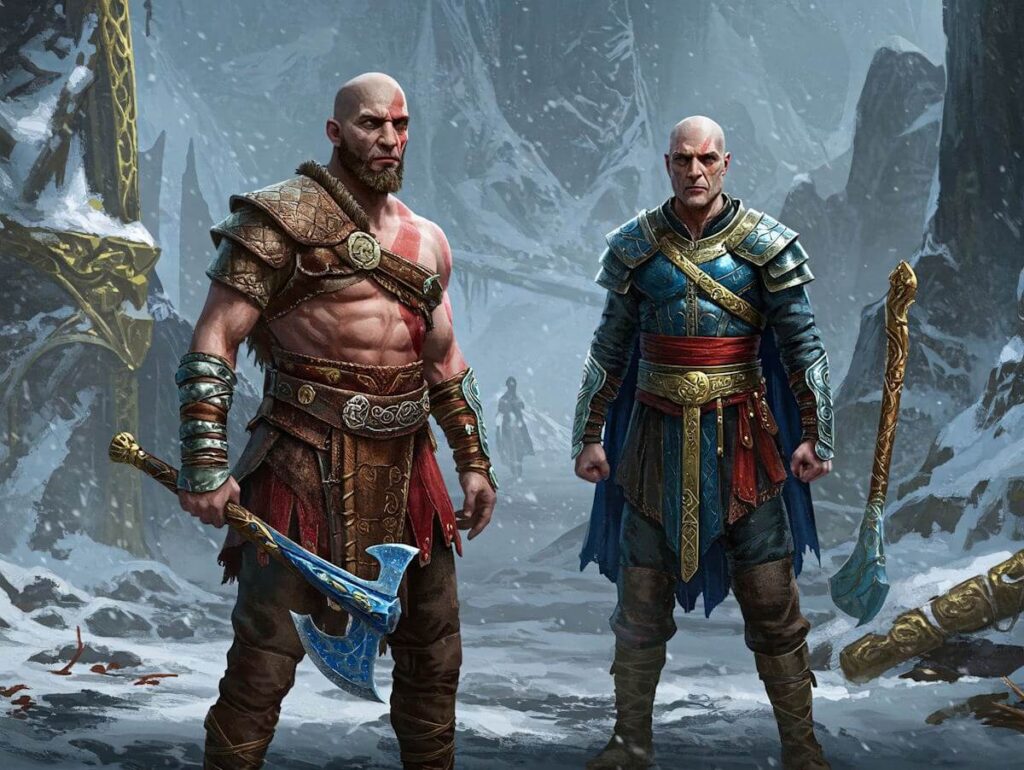Introduction to Open-World Gaming
The concept of open-world gaming has significantly transformed the landscape of the video game industry since its inception. Defined by expansive game worlds that allow players the freedom to explore, interact with, and manipulate various elements within the environment, open-world games have become a popular genre among gamers. The roots of this genre can be traced back to early titles such as “Adventure” on the Atari 2600 and “Zelda” on the NES, which laid the groundwork for more immersive experiences. Over the years, this framework has matured, showcasing increased complexity in narratives, environments, and gameplay mechanics.
Key characteristics that define open-world games include non-linear gameplay, rich storylines, detailed world-building, and the opportunity for player choices to have a significant impact on the game world. Unlike linear games that guide players through a prescribed series of events, open-world games encourage exploration and experimentation, thus enhancing player agency. Titles such as “Grand Theft Auto,” “The Elder Scrolls,” and “The Legend of Zelda: Breath of the Wild” exemplify the depth and breadth of experiences that can be provided within open worlds. These games have not only captivated audiences but have also influenced game design principles across the industry.
The evolution of open-world gaming has been shaped by advances in technology, including graphics, artificial intelligence, and online connectivity. As developers harness more powerful hardware, they are able to create increasingly vast and detailed worlds, complete with intricate ecosystems and dynamic weather systems. This evolution is noteworthy not only for how it enhances gameplay but also for how it fosters community engagement through multiplayer experiences and modding capabilities. In light of these developments, upcoming titles such as Starfield hold the potential to further define the future of open-world gaming, promising new levels of immersion and interaction that could reshape player expectations and experiences.
The Evolution of Open-World Games
The journey of open-world games has been marked by significant milestones that reflect advancements in gameplay mechanics, storytelling techniques, and graphical capabilities. Initially, titles like “Zelda: Ocarina of Time” pioneered this genre by introducing a sprawling world that allowed players to explore and engage with their environment in a non-linear fashion. This was a groundbreaking shift from the linear level designs prevalent in earlier gaming eras.
With the introduction of more powerful consoles and PC hardware, developers began to expand the boundaries of open-world gameplay. The release of games such as “Grand Theft Auto III” fundamentally changed how players interacted with virtual worlds, emphasizing freedom, choice, and the importance of a dynamic narrative woven into the fabric of an expansive urban landscape. The elements of player agency were taken further by incorporating complex missions and character arcs that flourished in the open environment.
Transitioning into the seventh and eighth generations of consoles, we witnessed stunning graphical improvements made possible through enhanced processing power and improved graphical technologies. Titles like “The Witcher 3: Wild Hunt” showcased rich storytelling combined with breathtaking visuals, presenting players with immersive landscapes that were not only visually arresting but teeming with life. This era marked a significant convergence of narrative depth and freedom, where player choices could influence the world in lasting ways.
As we stand on the cusp of the next generation, innovations in artificial intelligence, cloud gaming, and virtual reality are set to redefine open-world experiences. Starfield, with its promise of an expansive universe and intricate storytelling, is poised to take advantage of technological advancements, setting a new benchmark for what is achievable in open-world gaming. These factors underlie the evolution of the genre and position it for future exploration and innovation.
Starfield: An Overview
Starfield, developed by Bethesda Game Studios, is one of the most highly anticipated titles in the realm of open-world gaming. Known for their iconic franchises such as The Elder Scrolls and Fallout, Bethesda has built a reputation for creating expansive worlds filled with intricate storytelling and deep gameplay mechanics. Starfield represents the studio’s first original franchise in over 25 years, marking a significant milestone in their development journey. The excitement surrounding its release is palpable among fans and industry professionals alike.
The game is set in a vast universe, offering players the opportunity to explore diverse planets, engage in space travel, and encounter various forms of life. The grandeur of its setting distinguishes Starfield from other open-world games, as it enables players to traverse not just one world but an entire galaxy replete with unique ecosystems and storylines. Bethesda’s commitment to a rich narrative style is underscored by the promise of complex character interactions and branching story arcs, reminiscent of their previous works.
In terms of gameplay, Starfield introduces innovative mechanics, including customizable spacecraft and a robust crafting system that allows players to build and upgrade their own ships. These features enhance the exploration aspect of the game, inviting players to immerse themselves in the thrill of space travel. Additionally, the character creation system is designed to provide players with an unprecedented level of agency in shaping their in-game personas, setting a new standard for personalization within the medium.
The anticipation for Starfield is not only fueled by Bethesda’s storied past but also by the promise of pioneering game design that could redefine expectations for what open-world games can achieve. As the release date approaches, both fans and critics eagerly await the opportunity to navigate this new cosmic frontier.
Innovative Features in Starfield
Starfield is poised to redefine the open-world gaming landscape with a collection of innovative features that promise to enhance player engagement and experience. One of the standout elements is the use of procedural generation, which allows for the creation of vast and diverse environments. This technique not only provides players with a seemingly limitless universe to explore but also ensures that no two experiences are alike. By dynamically generating planets, star systems, and environments, Starfield seeks to immerse players in a living, breathing ecosystem where exploration feels organic and spontaneous.
Interstellar travel is another groundbreaking feature that Starfield brings to the table. Unlike many open-world games that limit players to a single large map, Starfield offers a sprawling cosmos where players can travel between planets, each with its own unique traits and ecosystems. This vastness presents new gameplay possibilities, allowing players to engage in various activities such as trading, combat, and exploration on an interplanetary scale. The ability to experience the intricacies of space travel could set a new benchmark for how open-world games approach navigation and exploration.
Additionally, deep character customization is central to the player experience in Starfield. This level of personalization goes beyond aesthetic modifications; it impacts gameplay mechanics and storylines, enabling players to mold their characters according to their preferences and play styles. By incorporating character backgrounds, skills, and decisions that influence the game world, Starfield is likely to deepen player investment and foster a stronger sense of agency. As players craft unique personas, the narrative becomes more engaging, leading to a richer overall experience.
In contrast to previous titles that have experimented with these features, Starfield appears poised to implement them in a cohesive manner. By seamlessly integrating procedural generation, expansive interstellar travel, and robust character customization, the game may indeed raise the bar for what players expect from open-world games in the future.
The Promise of Enhanced Immersion
The emergence of advanced technologies in gaming has paved the way for unprecedented levels of immersion, which is a fundamental promise of Starfield. At the forefront of this evolution is the remarkable advancement in graphics. Utilizing cutting-edge rendering techniques, Starfield is poised to deliver visually stunning environments that evoke a sense of realism rarely seen in open-world games. By employing high-definition textures, dynamic lighting, and complex environmental effects, the game creates lifelike worlds that players can explore. This visual fidelity invites players to engage more fully with the surroundings, making them feel as if they are truly traversing expansive alien landscapes.
Sound design plays an equally critical role in enhancing player immersion. In Starfield, a meticulously crafted audio landscape will complement the stunning visuals, offering a rich tapestry of ambient sounds, dynamic audio cues, and an immersive soundtrack. These auditory elements not only heighten the realism of space exploration but also contribute to the overall narrative experience. For instance, subtle changes in background sounds may signal impending dangers or opportunities, allowing players to remain alert and engaged. Such nuanced sound design ensures that players are not passive observers but instead active participants in the unfolding story.
Moreover, the integration of sophisticated artificial intelligence (AI) systems promises to revolutionize interactions within the game. NPCs powered by advanced AI will mimic real human behaviors, respond to player decisions, and forge dynamic relationships that develop over time. This layer of complexity elevates the narrative stakes, as players navigate a web of choices that influence their journey. By fostering genuine emotional connections with the game world and its inhabitants, Starfield deepens player investment in its storytelling. The combination of these technical and narrative innovations positions Starfield as a pioneering title in the realm of open-world games, promising an immersive experience that allows players to feel like integral parts of the universe they explore.
Potential Challenges for Open-World Games
Open-world games have experienced tremendous growth in popularity, yet they also face significant challenges that developers must navigate to ensure player satisfaction. One of the primary issues is game balance. Balancing open-world environments often requires intricate design to ensure that players encounter appropriate challenges at different progression points. If a game is too easy or difficult, it can lead to frustration, diminishing the overall enjoyment. Developers must meticulously calibrate skills, enemy strengths, and story progression to create a cohesive and enjoyable experience.
Another considerable challenge is content bloat. In an era where players expect vast landscapes filled with quests, collectibles, and side missions, there is a fine line between providing enough content and overwhelming players. Unchecked content growth can lead to a diluted experience; when players feel pressure to engage with a myriad of tasks, the core narrative may become lost amidst an overload of optional activities. Developers need to focus on creating meaningful experiences rather than simply filling the game world with busywork that offers little value.
Moreover, player fatigue presents an ongoing obstacle for developers of open-world titles. As players invest significant hours exploring these expansive worlds, there arises a risk of disengagement if the gameplay becomes repetitive or fails to introduce innovative mechanics. Starfield, like other anticipated titles, must not only meet but exceed player expectations to sustain engagement. This can involve integrating emergent gameplay systems and ensuring that exploration remains rewarding. By addressing these challenges, developers can create immersive open-world experiences that captivate players while avoiding common pitfalls. Through innovation and careful design, the future of open-world games can continue to evolve, with Starfield serving as a potential benchmark for the genre.
Comparative Analysis with Other Titles
The open-world gaming landscape has vastly evolved, with numerous titles pushing the boundaries of exploration, narrative, and engagement. Starfield, Bethesda’s latest venture, aims to carve its niche in this competitive arena alongside established giants like The Legend of Zelda: Breath of the Wild and Red Dead Redemption 2. Each of these games offers distinct strengths and experiences, making the comparison essential to understand how Starfield may resonate with audiences.
One of Starfield’s most ambitious features is its setting within a vast, procedurally generated universe. While titles like No Man’s Sky have attempted similar endeavors, Starfield is promising a more extensive narrative focus, which could enhance its appeal. Unlike No Man’s Sky, which faced criticism for its shallow gameplay at launch, Starfield aims to integrate meaningful storylines with its expansive environments, potentially providing a richer experience than its counterparts.
In terms of gameplay mechanics, Red Dead Redemption 2 is renowned for its attention to detail and character interactions. Players often cite the immersive storytelling and well-developed characters as some of the game’s greatest strengths. While Starfield may adopt elements of open-world realism and character development, it faces the challenge of establishing a comparable emotional connection between players and characters. A misstep in this area may leave players desiring deeper engagement.
Aesthetically, Starfield appears to be a blend of realistic visuals and imaginative concepts, drawing speculation about its potential impact on the player’s experience. When comparing to the artistic styles of Breath of the Wild and its vibrant landscapes, Starfield must deliver captivating visuals that resonate with players, ensuring it does not fall short in an age where graphics play a pivotal role in immersion.
Ultimately, as Starfield approaches its release, its ability to harmoniously combine these elements will determine its standing among other exceptional open-world titles. The competition is fierce, and player expectations could significantly influence its success or shortcomings within a dynamic gaming market.
Community Expectations and Speculation
The anticipation surrounding Starfield has ignited vibrant discussions across various online platforms, from dedicated gaming forums to social media channels. Members of the gaming community have expressed their excitement for Bethesda’s first new intellectual property in over 25 years, and the prospect of exploring a vast universe in an open-world environment. This excitement is reflected in the numerous speculative theories posted by fans, indicating a deep engagement with the game’s narrative potential and gameplay mechanics.
Many gamers hope that Starfield will push the boundaries of open-world game design, particularly in terms of exploration and immersion. There are discussions around the possibility of procedurally generated planets and an expansive universe that offers diverse environments and unique life forms. Fans are especially eager to see how the game tackles space travel and whether it will incorporate realistic astrophysics, allowing for a more authentic experience. Concerns have also been raised regarding performance and technical issues that previous Bethesda titles have experienced at launch, prompting players to voice their desires for a more polished experience in Starfield.
Moreover, gaming influencers and content creators have played a significant role in shaping community expectations. Their analyses often highlight the evolution of open-world games, drawing comparisons with genre-defining titles like The Elder Scrolls and Fallout. However, there remains a cautious optimism, as players speculate about the potential risks associated with high expectations. Discussions about the balance between narrative depth and expansive gameplay are prevalent, with fans debating how Starfield can innovate while remaining true to the strengths of open-world gaming.
As speculation continues, the gaming community remains keenly aware that Starfield’s release could redefine not only Bethesda’s standing in the industry but also the trajectory of open-world gaming as a whole. The collective excitement and thoughtful dialogue among fans illustrate the profound impact this title is anticipated to have on the future of video games.
Conclusion: Looking Ahead to the Future
As we delve into the future of open-world games, Starfield serves as a pivotal reference point for the evolving landscape of this genre. The discussions throughout this post have illuminated several key aspects: the innovative technologies that are being integrated into game design, the narrative complexities that players are beginning to expect, and the expanding realms of creativity that developers are exploring. These elements will not only characterize the gaming experience offered by Starfield but also set a new standard for future titles in the open-world category.
The potential for artificial intelligence and procedural generation to enrich vast game worlds is becoming increasingly apparent. These advancements promise players not only more immersive environments but also dynamic narratives that respond to their actions in real time. Such trends highlight the shifting paradigm where player agency is more significant than ever, allowing gamers to craft their unique stories within these expansive digital universes.
Furthermore, the integration of community feedback and player-centric design will likely redefine how future games are developed. The collaborative nature of gaming—encouraging players to contribute ideas and feedback—will help shape engaging experiences that resonate more deeply with audiences. With each iteration, open-world games like Starfield raise new questions about the role of storytelling, participant engagement, and technology in fostering empathy and connection through gameplay.
In conclusion, with Starfield on the horizon, the future of open-world gaming appears vibrant and full of potential. As advancements unfold and player demands evolve, we invite you to reflect on the exciting possibilities that lie ahead. What do you envision for the future of open-world games, and how might Starfield influence this trajectory? Your insights could pave the way for discussions that shape the next generation of gaming.





